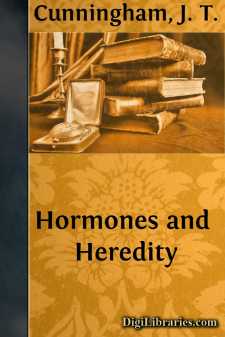Categories
- Antiques & Collectibles 13
- Architecture 36
- Art 48
- Bibles 22
- Biography & Autobiography 813
- Body, Mind & Spirit 142
- Business & Economics 28
- Children's Books 17
- Children's Fiction 14
- Computers 4
- Cooking 94
- Crafts & Hobbies 4
- Drama 346
- Education 46
- Family & Relationships 57
- Fiction 11829
- Games 19
- Gardening 17
- Health & Fitness 34
- History 1377
- House & Home 1
- Humor 147
- Juvenile Fiction 1873
- Juvenile Nonfiction 202
- Language Arts & Disciplines 88
- Law 16
- Literary Collections 686
- Literary Criticism 179
- Mathematics 13
- Medical 41
- Music 40
- Nature 179
- Non-Classifiable 1768
- Performing Arts 7
- Periodicals 1453
- Philosophy 64
- Photography 2
- Poetry 896
- Political Science 203
- Psychology 42
- Reference 154
- Religion 513
- Science 126
- Self-Help 84
- Social Science 81
- Sports & Recreation 34
- Study Aids 3
- Technology & Engineering 59
- Transportation 23
- Travel 463
- True Crime 29
Hormones and Heredity
by: J. T. Cunningham
Description:
Excerpt
INTRODUCTION
Historical Survey Of Theories Or Suggestions Of
Chemical Influence In Heredity
Weismann, strongly as he denied the possibility of the transmission of somatic modifications, admitted the possibility or even the fact of the simultaneous modification of soma and germ by external conditions such as temperature. Yves Delage [Footnote: Yves Delage, L'Hérédité (Paris, 1895), pp. 806-812.] in 1895, in discussing this question, pointed out how changes affecting the soma would produce an effect on the ovum (and presumably in a similar way on the sperm). He writes:—
'Ce qui empêche l'oeuf de recevoir la modification reversible c'est qu'étant constitué autrement que les cellules différenciées de l'organisme il est influencé autrement qu'elles par les mêmes causes perturbatrices. Mais est-il impossible que malgré la différence de constitution physico-chimiques il soit influencé de la même façon?'
The author's meaning would probably have been better expressed if he had written 'ce qui paraît empêcher.' By 'modification reversible' he means a change in the ovum which will produce in the next generation a somatic modification similar to that by which it was produced. It seems natural to think of the influence of the ovum on the body and of the body on the ovum as of similar kind but in opposite directions, but it must be remembered always that the development of the body from the ovum Is not an influence at all but a direct conversion by cell-division and differentiation of the ovum into the body.
Delage argues that if the egg contains the substances characteristic of certain categories of cells of the organism it ought to be affected at the same time as those cells and by the same agents. He thinks that the egg only contains the substances or the arrangements characteristic of certain general functions (nervous, muscular, perhaps glandular of divers kinds) but without attribution to localised organs. In his view there is no representation of parts or of functions in the ovum, but a simple qualitative conformity of constitution between the egg and the categories of cells which in the body are charged with the accomplishment of the principal functions. Thus mutilations of organs formed of tissues occurring also elsewhere in the body cannot be hereditary, but if the organ affected contains the whole of a certain kind of tissue such as liver, spleen, kidney, then the blood undergoes a qualitative modification which reacts on the constitution of the egg.
Suppose the internal secretion of a gland (e.g. glucose for the liver, glycolytic for the ferment for the pancreas) is the physiological excitant for the gland. If the gland is removed in whole or in part the proportion of its internal secretion in the blood will be diminished. Then the gland, if the suppression is partial, will undergo a new diminution of activity But in, the egg the specific substance of the gland will also be less stimulated, and in the next generation a diminution of the gland may result....


